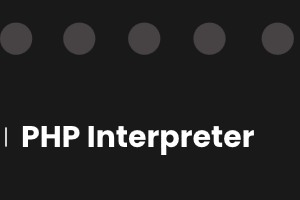Developers can create dynamic and interactive web apps using the PHP server-side scripting language. The interpreter, a key element in carrying out PHP code, is at the heart of PHP’s functioning.
The engine that powers PHP programmes is the PHP interpreter. It transforms PHP code that is comprehensible by humans into a form that a computer can comprehend and use. The essential activities, including variable assignments, function calls, and database transactions, are carried out by the interpreter as it reads the PHP code line by line.
Dynamic typing is one of PHP’s distinctive qualities. PHP, in contrast to statically typed languages, permits variables to be dynamically assigned values of various types while the programme is running. The PHP interpreter manages the dynamic typing issue by automatically handling memory management and type conversions. Let’s look at an illustration:
<?php
$num1 = 5;
$num2 = "10";
$sum = $num1 + $num2;
echo $sum;
?>
In this example, the PHP interpreter determines that `$num1` is an integer and `$num2` is a string. It automatically performs a type conversion and adds the values together to produce the result of 15. The interpreter seamlessly manages the memory and conversions behind the scenes.
The PHP interpreter is essential for managing errors. Code exceptions, runtime issues, and syntax problems are all found and reported to the developer. The interpreter helps developers find and fix problems in their PHP applications by supplying thorough error reports. Think about the following instance:
<?php
function divide($numerator, $denominator) {
if ($denominator == 0) {
throw new Exception("Division by zero is not allowed.");
}
return $numerator / $denominator;
}
try {
echo divide(10, 0);
} catch (Exception $e) {
echo "Error: " . $e->getMessage();
}
?>
In this code snippet, the `divide()` function attempts to divide `$numerator` by `$denominator`. The PHP interpreter detects the division by zero and throws an exception. The `try-catch` block allows the developer to catch the exception and display a custom error message. The interpreter ensures the smooth execution of error-handling mechanisms.
The interpreter includes a function called OpCache to improve the performance of PHP applications. OpCache eliminates the need to recompile PHP scripts for every request by storing precompiled bytecode in shared memory. This caching approach drastically cuts the execution time, improving the responsiveness and scalability of the programme.
The core of PHP development is the PHP interpreter, which converts readable code into usable instructions. It is essential for building reliable and practical web applications that can handle dynamic typing, automatic memory management, error detection, and performance optimization.
jQuery presents a tree-like structure of all the elements on a webpage simplifying the syntax and further manipulating such elements. The jQuery Certification exam by StudySection will secure your fundamental knowledge and a basic understanding of jQuery as an asset to improve your skills.




